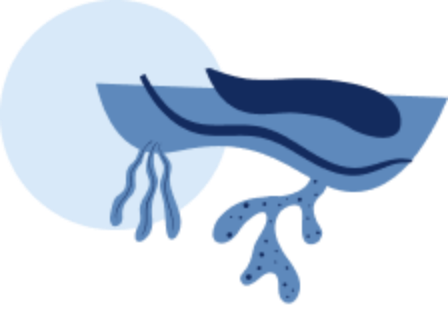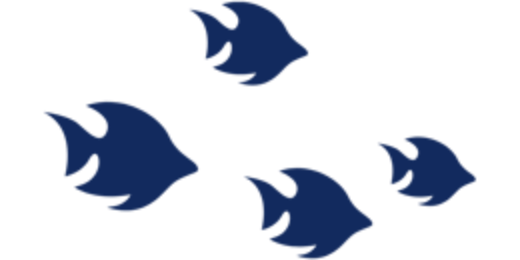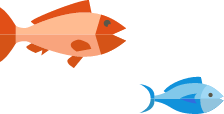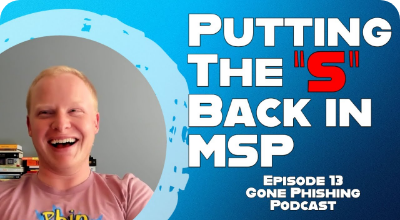


Transcript:
Connor Swalm:
Welcome to Gone Phishing, a show diving into the cybersecurity threats that surround our highly connected lives. Every human is different. Every person has unique vulnerabilities that expose them to potentially successful social engineering. On this show, we'll discuss human vulnerability and how it relates to unique individuals. I'm Connor Swalm, CEO of Phin Security, and welcome to Gone Phishing. Hey, everyone. Welcome back to another episode of Gone Fishing. I'm your host, Connor, CEO at Phin Security, and I am joined by Tom Lawrence, the founder and CEO of Lawrence Technology. Tom, how are you doing today?
Tom Lawrence:
I'm doing great.
Connor Swalm:
Awesome. So today we got a special treat for all of you listening. We have a three part series. So this is part one of that three part series on how to use. Should you be using YouTube to grow your business or your MSP?
Tom Lawrence:
There'll be some how in here, too, so keep listening.
Connor Swalm:
There will be a little bit of how, but mostly just us telling you, yeah, wagging the finger and saying, you should be doing these things. For those of you that don't know, Tom also runs what I would consider an extremely successful YouTube channel. Several hundred thousand subscribers.
Tom Lawrence:
Yeah, about 300,052. 53 million views, depending on when you're listening to. It's at least that much or more.
Connor Swalm:
And a podcasting studio that is much better and built out than mine. So very jealous.
Tom Lawrence:
It takes time, but yes.
Connor Swalm:
So YouTube can be used to generate a lot of business. I know you and I have talked about this a lot before. So it's like a stand in or it helps marketing. Why do MSPs struggle with marketing in the first place? What's typically where they miss the mark?
Tom Lawrence:
It's sometimes where you position yourself and if you look up and easy good books to read around, it is story brand telling. I believe it's actually the name of the company is story brand. Maybe I'll find some stuff to put in the show notes later. Exactly which books? But if you just think about how to build narrative in storytelling, and that's where they're sometimes just not doing it, they go, hey, look. And I see posts all the time. I engage with in different forums. One of them recently, hey, I want to start another MSP. All right, what's your differentiating? What's your marketing plan? I'm really good at tech, is all the person kept repeating. I'm like, well, great. That does not attract customers to you.
And then putting out a story about, did you know we're the best of the best when it comes to doing all these tech things? And you find a lot of people. Great. Your skills are greatly appreciated as an employee. Somewhere where you are very technical, I can hand things to you. You're going to get them done. That's awesome. Pat on the back. Great. That is not the same as marketing. That's not how you engage a business. And that concept from technical founders, which are going to be the majority of your msps, to building that into a successful business, is a big gap. That is the marketing side of it. And sales will just sow in there as well. Because if you don't have the marketing, get the people calling you. You don't even know how to close.
Connor Swalm:
Yeah. I was having this exact conversation with a buddy of mine, Alex Farling, where if your whole sales pitch is look at all the tools I use, you've immediately lost. You're not describing the value that you actually provide, which is the outcome you want to give your client.
Tom Lawrence:
Never talk tools with a client. Unless they ask. Unless they ask. I never hide my tools that we use. It's just not the conversation starter.
Connor Swalm:
There's also about a hundred YouTube videos on every tool you probably have.
Tom Lawrence:
Yeah, I actually go in depth and I have reviews of all the tools we use, most of them at least, and more on the way. But nonetheless, when it comes to the client side, you see all the analogies. You don't sell them the ingredients, you sell them the cake, et cetera. But really, it starts with that common language, common conversation and listening of what do they need? And then how to position yourself as someone who helps them on their journey to solving their tech problem. Not presenting the solution to them, but thinking about how you become a partner on their journey. That's the first step in the marketing plan that you need to do is how are you going to be the assistant, how are you going to not be the hero, but be that hero's sidekick.
And this is just this narrative of storytelling. And any movie has something like this too, where it's not just the hero. Hero has a goal, but then there's always that person that helps them, that gives them the sword, that puts the shield on them, and that's what you want to be, is that person that can equip them. And when you start from that perspective of marketing, it's a good way to think about it. But let's bring it all the way back to YouTube. Now that we've answered why they're bad at it for often not understanding that part of the hero's journey and what their role is in the hero's journey. They're not the hero, they're not current.
Connor Swalm:
Why did you start YouTube for your business?
Tom Lawrence:
So public speaking is actually a big piece of what I was doing previously and well, I say previously, I'm still doing public speaking. What changed though was when I was speaking at actually a Linux conference. So I do talk for business conferences, things that are going to be related to my it business, but I also engage a lot with the tech community and hacking community. So I was doing a talk and it really clicked to me with some says, why don't you throw this on YouTube? Because there's only so many people that can fit in a room and the way the talks are divided up, more people want to see my talk room limit hit. And then people said, throw it on YouTube.
I said, sure, but who wants to watch a video about firewalls on, you know, talking in depth about open source firewalls and rules and vlans? And turns out a whole lot of people, I was wrong about some of that. So that kind of really sparked it for me to start putting deeply technical tutorials and sharing my experience. And it also kind of aligned with the goals I had of going, how do I want to raise more awareness for technology, engage more on the community? I like doing this, but not everyone can make it to the conferences and you can only go to so many conferences because there's finite amount of time. So from a scalability, I said, yeah, this YouTube thing is pretty popular. Look at this Linus guy and these other people doing technical videos.
But I realized once you start a niche of going down some of the niches I did, you build a bigger audience around it and it just kind of fell in naturally.
Connor Swalm:
That makes a lot of sense. And what was the early trajectory you saw? Was it straight up into the right immediately or slog?
Tom Lawrence:
You have to really be committed and understand YouTube is a long game. It's going to be the longest one of any of the social media platforms you may find on some of the short ones, especially if you're in an entertainment category. And this can apply to YouTube as well. You may take off fast, but if you're looking to grow a different audience, a more engaged, in depth, community driven audience that follows you for being very technical, that takes time. Everyone likes to be the person telling jokes and entertaining. That can get you a bunch of views really quick. But ask any comedian on the road, man, that's a tough gig. And will that even help your business? Is there any business alignment to it that you could potentially ink out of it.
That's a whole nother topic, but it's going to be really hard if you're going to do it from the technical side and you want to think and you ask, the answer is a great book on this topic and that's what you have to ask. What are the customers asking? What would your customers be searching for? Help with outlook, how to set something up, how to set up some of their network. I usually go even more technical and that's that goal I had on there was to slowly over time and realizing that, hey, those three views are probably because I refreshed the page three times. That's the reality of getting started in YouTube. You're going to take a long time to get the audience.
You always have to really make sure you're providing value and don't be afraid to be critical of yourself or listen to the criticism. Others going, wow, you didn't teach me. You just told me how great you at it and you left out half the instructions. I definitely have videos like that. I've left some of them up. I let people go through my old videos from years ago and going, wow, this guy's bad. People think because there's not something on YouTube that there's not an audience for it and that isn't necessarily true at all. There's people looking for it and if they don't find it doesn't mean they don't stop looking for it. Matter of fact, YouTube is the second largest search engine, only next to its parent company itself, Google.
And Google takes and indexes all the YouTube videos, including the words you use in them. They are extremely detailed in how they do this. So when people are searching for anything, if you happen to have a video that will very likely rank higher than a blog post on the same topic, like how to set up this firewall rule, how to do these VPN things, that actually is something why it's so important, just because it's not there doesn't mean it shouldn't be there. And this is where people even told me I didn't think there'd be an audience for it. But now that there's an audience for it, there's now a bigger audience. And I have more and more people doing this that are my friends now on YouTube. I helped a couple of them launch their channels.
One of them actually used my studio for like two years and I'm like, yeah, I encouraged it and they're like, well, isn't it competitive? I said, no, YouTube's collaborative because people watch more than one review on a product before buying a product. Matter of fact, the challenge they have and the comments I get frequently is, well, you're the only one reviewing it. Or only you and your friend Jay, or your friend Cody. There's only three people that reviewed it. I'm like, yeah, who else can I find that reviewed this? That was actually an argument in a forum yesterday. They're like, there's not enough people. They actually were asking the people that make the products, how do you get more open source people and advocates on YouTube making the videos about it?
I'm like, there's literally demand and no one's making videos about it besides me and my friend.
Connor Swalm:
There are enough people around the world with access to YouTube and Google that quite literally any topic you'd like to talk on could get a huge audience in comparison to people you could speak to in a room.
Tom Lawrence:
Yeah, it really is. And the business stuff that we even have a separate business channel we started just because the number of business comments on there and it doesn't get the same amount of views. But we are talking a lot about the MSP business space, dropping everything on there. I recently am going through a merger on July 1 of 2023, and we have whole videos on those topics. Once again, you're like, well, you're just sharing a bunch of info with the MSP community. Turns out being friends with MSPs works out really well for your benefit. And you're going out there sharing knowledge, and that creates a lot of connectivity.
Connor Swalm:
In the community for those that are listening. What's the name of that business podcast if they'd like to take a look at it?
Tom Lawrence:
Oh, it's called Business Technicalities. Lawrence.video/biz. I made a short URL server I have set up that I have so I can quickly index and relay things without people having to try to spell. Turns out, dumb idea was calling it business technicalities. I misspelled technicalities a lot, it turns out.
Connor Swalm:
How many s's are in business again?
Tom Lawrence:
I get that wrong occasionally too. Not my thing.
Connor Swalm:
We'll have that information in the show notes in case anyone wants to take a look as well. Do you have to be ultra extroverted to talk in front of a camera all the time?
Tom Lawrence:
Not at all. Matter of fact, I'm a very introverted person. But like most people in the tech space, the nerds of the world, you get us on a topic that we like talking about YouTube being among them. You want to talk to me about storage servers? I'm game virtualization come on, let's have a conversation. And because it's something, you're often a subject matter expert, definitely do it. People like watching. When people are passionate about things and you're already in the tech space. You work at an IT services and MSP business because you're passionate about tech. Bring that with you. And you just talk to the camera because you're talking about something you're a subject matter expert in that you're passionate about, and it makes it a whole lot easier.
So it doesn't really require being extroverted at all because you don't realize how lonely this is. I stare into the black abyss of a camera lens. There's no one in the room with me right now. Me and you are having a conversation. But when I produce content, when I produce tutorials, that means sometimes 1213 hours of me sitting in this cool little studio in silence because there's a lot of sound deadening in here. I put something on because of silence, how that silence is deafening, actually. People come, my studio, go, it's kind of weird in here. I'm like, yeah. I said I have to have something going just so I don't go insane. So it's actually great for introverts. You're using your voice, but you're not talking to a person. You just stare at the lens. Talk to the lens.
And there's no awkwardness because it doesn't exactly stare back at you other than it being inanimate.
Connor Swalm:
So if I connect that to a point you said earlier was basically, people all the time struggle with getting too technical early on. They're not explaining the value of what they provide and the services and the partnership that they offer to their clients. But then you use these YouTube videos as an opportunity to dive into these super technical things, which it sounds like you did that because you liked it to begin with.
Tom Lawrence:
Oh, yeah, definitely passionate about it. This is why I go speak for free at all these open source conferences. I'm excited when these talks get accepted. I'm like, cool. We get to be on stage and I get to share a bunch of knowledge of people and teach them about something that is something I've always been passionate about. I always joke, we're nerds and it's like show and tell. We're so excited. Hey, cool. You like the thing I did?
Connor Swalm:
It's like bringing in a Rubik's cue for show and tell in second grade. It is.
Tom Lawrence:
It never got appreciated as much when I was in high school or not high school, in elementary school, going back a lot of years for me. I would always find the weirdest gadgets to bring. So I was like the nerd. I was like, oh, science day. Come look at what my little project is.
Connor Swalm:
You did more than the baking soda volcano science fair came.
Tom Lawrence:
I love. That was me, man. That's my jam. Like, I can show off my nerd skills.
Connor Swalm:
Tom brought an actual smoke bomb into school today and got expelled. That is more accurate to what happened so early on. When you were building this YouTube channel making all these videos, did you post all that content elsewhere as know?
Tom Lawrence:
That's where it gets a little tricky. So you'll hear a lot of people talk about LinkedIn. And I'm not saying LinkedIn's bad. LinkedIn has a terrible discovery for after the fact. It's of the moment. Things trend and then they fall off. Maybe you'll get seven days out of there. I've actually created some marketing automation using Zapier, where it grabs things off my channel. It tweets it puts it on LinkedIn, it posts on other social automatically. For me, I add some words. It's pretty easy to set that up. You don't have to. That's your low code, no code solution is zapier to do all this. You just connect and say yes a lot to channels and LinkedIn. So it's not bad to post on LinkedIn to grab an audience there. But LinkedIn does not favor content that brings you away from LinkedIn.
This is actually true for any social media platform, but that doesn't mean you shouldn't post on there. What I don't encourage because of the lack of discoverability, it's a grindy game to try to build a LinkedIn audience where you're just hammering constant feeds on there and hoping enough people interact with you to get engagement. That can be really hard. You even look at people that have successfully navigated LinkedIn better than I have. We'll talk about like John Hammond and all of his hacking videos that he does. And you have Jeff gearling. He got known for a lot of the pretty wild raspberry PI project. Once again, they've got LinkedIn followings that are big, but think about it from scale. I think John Hammond, less than 50,000 people follow on LinkedIn. He's lucky when he gets like 100 people like this post.
It shows that even with that high level following, I don't say not to post on there, but I wouldn't try exclusively. I've have a few friends that are pushing that. I'm like, even they admit it's good conversions when they get them, but it's not near the engagement or discoverability, and it doesn't have the evergreen that YouTube does. So if you have something you want out there that you want people to discover right now, there is no better platform than YouTube to kind of keep that going.
Connor Swalm:
And that sounds like because it's tied directly into the way Google ends up filtering search results.
Tom Lawrence:
Yeah, it really comes down to the combination of people use Google for search, it's tied into the search results. It's going to show up way more, matter of fact, because of the way bing stops much of the filtering results. And recently, I don't know if it's by accident or idiocy, Twitter is now delisted from much of Google. But the same problems you post on these other social platforms, Google is always going to prefer their own properties because that property for Google is also an ad method for them. So like it or not, that's a situation we're in. So, hey, play the game as the cards were dealt. And that's the current best platform to do here in 2023.
Connor Swalm:
Well, any last minute tips for folks who are looking thinking about this in some way, shape or form?
Tom Lawrence:
Oh, I think we'll have some more in the next videos where we dive a little more tips for them. But basically it's just get started. You don't have to cover the things we talked about here. You don't have to be extroverted. You just have to be passionate. You have to think about what the customers are asking, how you can answer those questions and kind of get started and run with it.
Connor Swalm:
Awesome.
Tom Lawrence:
It's going to be terrible. Just accept it. This is how you get better.
Connor Swalm:
First video is going to be terrible. Just get started. I love it. Awesome. Well, in part two, we're going to be discussing how to actually get started. So we're not just people here pointing at the screen saying, go do this, and if you don't, you're losing out. We're actually going to listen tom explain how to get started on YouTube and what some of those maybe early pitfalls you should avoid are and how you should think about going about it.
Tom Lawrence:
Absolutely.
Connor Swalm:
Awesome. Thanks again, everyone, for joining us. I'm Connor, host Gone Fishing podcast. And I'm Lawrence joined us today.
Tom Lawrence:
Thank you.
Connor Swalm:
Thanks so much for tuning in to Gone Fishing. If you want to find out more about high quality security awareness training campaigns, how to launch them in ways that actually engage employees to change their habits, then check us out. Phin Security at phinsec.io or click all of the wonderful links in our show notes. Thanks for fishing with me today and we'll see you next time.






